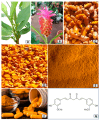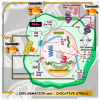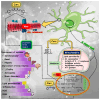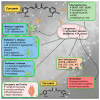Curcumin: A Golden Approach to Healthy Aging: A Systematic Review of the Evidence
- PMID: 39203857
- PMCID: PMC11357524
- DOI: 10.3390/nu16162721
Curcumin: A Golden Approach to Healthy Aging: A Systematic Review of the Evidence
Abstract
Aging-related disorders pose significant challenges due to their complex interplay of physiological and metabolic factors, including inflammation, oxidative stress, and mitochondrial dysfunction. Curcumin, a natural compound with potent antioxidant and anti-inflammatory properties, has emerged as a promising candidate for mitigating these age-related processes. However, gaps in understanding the precise mechanisms of curcumin's effects and the optimal dosages for different conditions necessitate further investigation. This systematic review synthesizes current evidence on curcumin's potential in addressing age-related disorders, emphasizing its impact on cognitive function, neurodegeneration, and muscle health in older adults. By evaluating the safety, efficacy, and mechanisms of action of curcumin supplementation, this review aims to provide insights into its therapeutic potential for promoting healthy aging. A systematic search across three databases using specific keywords yielded 2256 documents, leading to the selection of 15 clinical trials for synthesis. Here, we highlight the promising potential of curcumin as a multifaceted therapeutic agent in combating age-related disorders. The findings of this review suggest that curcumin could offer a natural and effective approach to enhancing the quality of life of aging individuals. Further research and well-designed clinical trials are essential to validate these findings and optimize the use of curcumin in personalized medicine approaches for age-related conditions.
Keywords: Curcuma longa; aging; cardiovascular diseases; clinical trials; curcumin; frailty; inflammation; neurodegeneration; oxidative stress; sarcopenia.
Conflict of interest statement
The authors declare no conflicts of interest.
Figures







References
-
- Baig J., Sawant N., Rawat P., Reddy A.P., Reddy P.H., Kshirsagar S. Abnormal interaction of Rlip with mutant APP/Abeta and phosphorylated tau reduces wild-type Rlip levels and disrupt Rlip function in Alzheimer’s disease. Biochim. Biophys. Acta Mol. Basis Dis. 2023;1870:166858. doi: 10.1016/j.bbadis.2023.166858. - DOI - PubMed
-
- Chiu C.C., Cheng K.C., Lin Y.H., He C.X., Bow Y.D., Li C.Y., Wu C.Y., Wang H.D., Sheu S.J. Prolonged Exposure to High Glucose Induces Premature Senescence Through Oxidative Stress and Autophagy in Retinal Pigment Epithelial Cells. Arch. Immunol. Ther. Exp. 2023;71:21. doi: 10.1007/s00005-023-00686-9. - DOI - PubMed
Publication types
MeSH terms
Substances
Grants and funding
LinkOut - more resources
Full Text Sources
Medical

